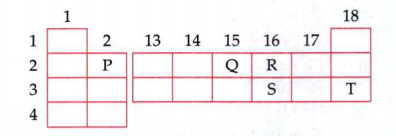Element P belongs to first group and fourth period of the periodic table. Element Q succeeds P in the . group and element R succeeds Q in the period. The correct increasing order of their atomic radii isA Q
Correct option c P
Related Solutions
The atomic number of elements P, Q, R, S and T are given. Which element belongs to 3rd period of periodic table?
View SolutionThree elements P, Q, and R have successive atomic numbers with same period . If P > R > Q in terms atomic size. Predict the group of each element. Give reason.
View SolutionThe table given below shows the mass number and number of neutrons in four elements P, Q To which periods do P, Q, R and S belong?
View SolutionListed below are the locations of certain elements in groups and periods of the periodic table. Arrange these elements in the expected order of increasing first ionisation energy. P: Element in the fourth period and group IVA Q: Element in the third period and group VIA R: Element in the sixth period and group IIIA S: Element in the second period and group VIIIA T: Element in the fourth period and group VIA
View SolutionA part of periodic table is shown in the following figure
 Arrange elements 'P',Q' and 'R' in increasing order of their metallic character.View Solution
Arrange elements 'P',Q' and 'R' in increasing order of their metallic character.View SolutionIf P, Q, R and S are elements of 3rd period of p-block in modern periodic table, among these one element is metal and rest are non-metals and their order of electronegativity is given as:
Q. Chloride compound of which element is hypovalent?View SolutionIf P, Q, R and S are elements of 3rd period of p-block in modern periodic table, among these one element is metal and rest are non-metals and their order of electronegativity is given as:
Q. Chloride compound of which element is hypovalent?View SolutionIf P, Q, R and S are elements of 3rd period of p-block in modern periodic table, among these one element is metal and rest are non-metals and their order of electronegativity is given as: P lt Q lt R lt S Q. Chloride compound of which element is hypovalent?
View SolutionIf P, Q, R and S are elements of 3rd period of p-block in modern periodic table, among these one element is metal and rest are non-metals and their order of electronegativity is given as:
Q. Chloride compound of which element is hypovalent?View SolutionThe positions of three elements P, Q and R in the periodic table are shown below

Which of these three elements is most non-metallic ?View SolutionIf P, Q, R and S are elements of 3rd period of p-block in modern periodic table, among these one element is metal and rest are non-metals and their order of electronegativity is given as: P lt Q lt R lt S Q.
View SolutionIf P, Q, R and S are elements of 3rd period of p-block in modern periodic table, among these one element is metal and rest are non-metals and their order of electronegativity is given as:
Which element is expected to form amphoteric oxide?View SolutionThe table given below shows the mass number and number of neutrons in four elements P, Q To which groups do P, Q, R and S belong?
View SolutionIf P, Q, R and S are elements of 3rd period of p-block in modern periodic table, among these one element is metal and rest are non-metals and their order of electronegativity is given as:
Which element is expected to form amphoteric oxide?View SolutionIf P, Q, R and S are elements of 3rd period of p-block in modern periodic table, among these one element is metal and rest are non-metals and their order of electronegativity is given as:
Which element is expected to form amphoteric oxide?View SolutionFor any three sets. is an element of , then S may belong to
View SolutionIf P, Q, R and S are elements of 3rd period of p-block in modern periodic table, among these one element is metal and rest are non-metals and their order of electronegativity is given as:
In which of the following linkage release of is relatively more easier?View SolutionIf P, Q, R and S are elements of 3rd period of p-block in modern periodic table, among these one element is metal and rest are non-metals and their order of electronegativity is given as:
In which of the following linkage release of is relatively more easier?View SolutionConsider the following information about element P and Q: {:(,"Period number","Group number"),(P,2,15),(Q,3,2):} the formula of the compound formed by P and Q element is:
View SolutionConsider the following information about element P and Q:
the formula of the compound formed by P and Q element is:View Solution
